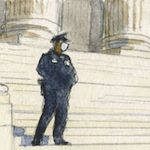New York tells justices not to intervene in conflict over attendance limits at worship services

New York Gov. Andrew Cuomo urged the Supreme Court on Friday to stay out of the state’s battle with two Orthodox Jewish synagogues in New York City over an executive order that limits attendance at houses of worship as part of an effort to combat the coronavirus. Cuomo told the justices that because of “continued progress in containing COVID-19 spread,” the restrictions that the synagogues asked the court to block no longer apply to them.
Cuomo, a Democrat, issued the order at the heart of the dispute in October. The purpose of the order and the initiative that the order implemented, Cuomo explained in Friday’s filing, is to identify clusters of COVID-19 cases, to take “short-term aggressive measures” in and around the areas where those clusters are located to prevent the virus from spreading, and then to monitor the cases to determine how to proceed from there. When a cluster is identified, the area immediately around the cluster is known as a “red” zone; the area around the red zone is known as an “orange” zone, and the area around the orange zone is known as a “yellow” zone. Attendance at worship services is limited to 10 people at religious institutions in the red zone and 25 people in the orange zone. Attendance in the yellow zone is limited to 50% of the building’s maximum occupancy.
The synagogues challenged the 10- and 25-person restrictions in federal court in New York, arguing that the restrictions make it impossible for them to hold services for all of their congregants. The district court denied a request to block the enforcement of the order, and the U.S. Court of Appeals for the 2nd Circuit declined to step in while the synagogues appealed. The synagogues then came to the Supreme Court on Tuesday, asking the justices to put the restrictions on hold or, in the alternative, grant review without waiting for the 2nd Circuit to rule on their appeal.
In a filing by New York Solicitor General Barbara Underwood, the state emphasized that its efforts to control the disease are working. As a result, the state explained, the synagogues (and the rest of New York City) are now in yellow zones, where houses of worship are restricted to 50% of maximum occupancy – a limit that the synagogues are not challenging.
But in any event, the state continued, both the district court and the 2nd Circuit rejected the synagogues’ assertion that the executive order was motivated by hostility toward the Orthodox Jewish community. The different zones, the state noted, affect various businesses and religious institutions. Some zones do not contain any Orthodox Jewish communities, while some Orthodox Jewish communities are “left untouched.”
Although Cuomo, in an October press conference, acknowledged the prospect that his order could affect worship services, the state added, he “made clear that the order did not target any gatherings because of their religious nature.” Instead, the state explained, the order was focused on “mass gatherings” – such as at houses of worship – because of their “super-spreader potential.”
Cuomo did not, the state stressed, blame the spread of COVID-19 on the ultra-Orthodox Jewish community. And if anything, the state observed, the executive order treats religious gatherings more favorably than secular activities that involve comparable risks – such as plays, concerts, spectator sports and movies – by allowing them to remain open, with limits on attendance.
The state also pushed back against the synagogues’ suggestion that blocking enforcement of the restrictions would bring the state “into line with the approaches of other States.” “The approaches of other states,” New York told the justices bluntly, “are not working,” as current COVID statistics reflect. Even if “public officials in other states may deem certain measures sufficient to protect their own citizens,” New York concluded, that “does not prevent New York State from pursuing a different public health strategy.”
Finally, the state rejected the synagogues’ suggestion that the court should take up their appeal before the 2nd Circuit can decide it. Because the 10- and 25-person limits do not apply to the synagogues now, the state noted, there is no urgency to their request; moreover, the 2nd Circuit has agreed to fast-track their appeal, with oral argument scheduled for Dec. 18.
The state made similar arguments on Wednesday in opposing a request by the Roman Catholic Diocese of Brooklyn to lift the attendance limits. In its filing in that case, the state praised the steps that churches have voluntarily taken to try to reduce the risk of COVID-19 transmission. But those measures, the state argued, should not provide an exemption from the attendance limits: Among other things, those protocols have not yet been independently tested in COVID hotspots. And the state is not required, it continued, to “negotiate COVID-19 restrictions for each and every house of worship on a building-by-building basis.”
Shortly after filing its opposition on Wednesday, the state sent a letter to the court to inform the justices of the changes to the classification of the areas where the diocese’s churches are located. As of Nov. 20, the letter explained, “none of the Diocese’s churches will be affected by the gathering-size limits it seeks to enjoin.”
This post was originally published at Howe on the Court.
The post New York tells justices not to intervene in conflict over attendance limits at worship services appeared first on SCOTUSblog.


